
This is one of those questions that seems to get people talking - sometimes very heatedly!
To answer it properly, we need to look at all the facts, dispel some myths, and keep an open mind.
To start this Roof Clean Spray Team blog, it might be best to explain what we mean by sealing roof tiles.
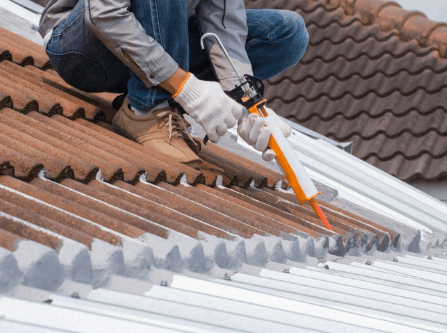
First off, the term 'sealing' can be misleading, and this is what causes most of the fuss. Sites like Reddit and Quora are filled with irate roofers and armchair experts who express their opinions strongly, stating either that sealing roof tiles is a waste of time, will ruin your tiles, or is an outright scam!
But the main point here is this - they are just opinions, and they are based on a fundamental misunderstanding, not the facts.
As experts in the industry, we can say categorically that sealing roof tiles completely would be a huge mistake. The way roof tiles overlap means water runs off and into the gutters, and the different types of tiles all act in much the same way, keeping your home watertight.
Some materials are porous, and others less so (another point we need to deal with!), but porous roof tiles allow moisture to escape. On their own, they do a pretty good job, but they have a limited lifespan (which we'll come to later).
Slapping on a coating that fills up all the holes and seals them completely would trap moisture within the tile and not allow it to evaporate from within the loft space. This would lead to mould, penetrating damp, rotting timbers and condensation issues, resulting in some expensive repairs sometime in the future.
So, no, sealing roof tiles isn't about creating an impermeable surface that would cause these problems, it's about applying specialist coatings that enhance your roof's ability to cope with rainwater and protect it from the elements.
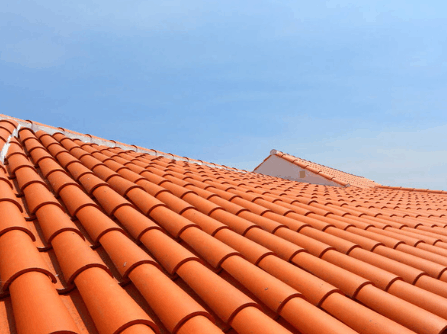
Here we run into another contentious issue. Google the question, "Are roof tiles porous?", and you'll get conflicting answers!
Again, it (mostly) comes down to a misunderstanding of the term, as some people have a different idea of what it means. So, let's try to bring some clarity and common sense into the equation...
Regardless of what you might read or hear elsewhere, clay tiles and concrete roof tiles are, in fact, porous. By this, we mean they have low porosity, allowing a small amount of water absorption. Concrete tiles are, like natural stone, porous by nature, whatever anyone might tell you. However, they usually have a protective coating applied during the manufacturing process, which helps water to run off without being absorbed, and this coating tends to wear off after a while.
This is backed up by the fact that they attract moss and other organic matter, as plant growth anchors itself to the porous surface. Clay tiles, likewise, attract moss, lichen and algae growth due to their porous nature.
Those who argue against this claim that concrete roofing tiles actually become less porous with time, and while there's an element of truth to this, it's not always the case. Although minerals in the tile can migrate to the surface, creating a denser material that hardens with age, natural weathering, combined with the effects of heavy soiling and organic growth, attacks the tile surface and causes it to deteriorate.
This means, in many cases, the tiles become more porous rather than less. And that's why it's a good idea to seal roof tiles!
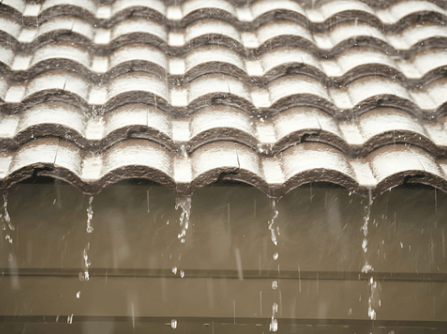
Unless you have a flat roof, most properties in the UK have a sloped roof (or pitched roof), meaning that there's a steep slope of roof tiles on two sides. The slope is what helps water to run off of tile roofs, as gravity pulls the rainwater down onto the next tile, due to the tiles overlapping each other.
Unlike asphalt shingles or slate, a tile roof stays in place under its own weight; each one presses down on the tile beneath.
This is designed to prevent water from entering the roof space, and on the whole, it works well, even if the roof is made from a porous material (even concrete porous tiles). The only time it usually fails is when there are missing tiles or cracked tiles.
Hairline cracks can appear over time due to constant weathering from UV rays, wind, rain and the freeze-thaw cycle. And if a tile breaks, water will leak into the loft space where it can cause a lot of damage!
A tile roof in the UK is designed to last between 20 and 30 years. Any that are over 60 years old are considered very old roofs!
While the roof pitch helps - as water runs off a steeply pitched roof much more easily - old roof tiles are susceptible to damage from moss, lichen and algae growth.
These organic materials absorb water, which can drastically increase the weight of the roof. Moss in particuar can absorb up to ten times its dry weight, adding as much as 7,000kg to a large roof, which can cause structural damage.
Old concrete tiles are particularly vulnerable - despite the nonsensical claims to the contrary - as the surface begins to crumble, allowing water into the property.
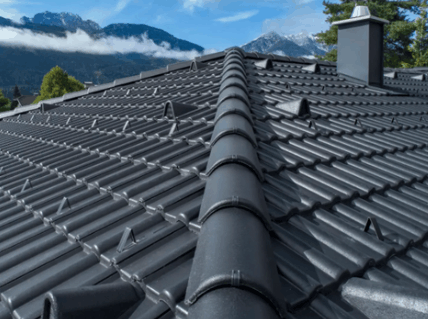
Applying a roof sealant offers a whole host of benefits that you could be missing out on!
Here are some to consider...
Roof tile sealing enhances water resistance by reducing the tiles' ability to absorb moisture. This prevents water penetration into porous materials like concrete or clay, protecting the roof from water damage, leaks, and freeze-thaw cycles that can cause cracking during the colder months.
Sealing old tiles inhibits the growth of algae, moss, and lichen, which thrive in damp environments. These growths can stain the roof, degrade the tiles over time, and even compromise their structural integrity. A waterproof coating keeps the roof cleaner and more resilient to biological growth.
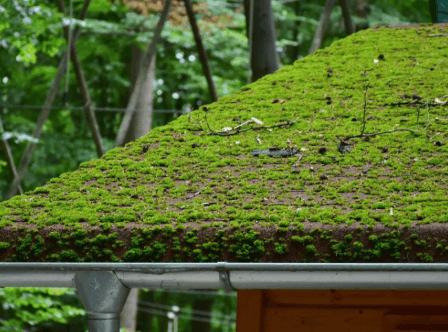
Sealed tiles are better protected against UV radiation, which can cause fading, cracking, and other forms of weathering. This is especially beneficial in areas with intense sunlight, where unprotected tiles might deteriorate more quickly.
By creating a tougher outer layer, sealing strengthens roof tiles and reduces wear from environmental factors like wind, rain, and debris. It also increases resistance to harsh conditions such as heavy rain, frost, and hail, prolonging the life of the roofing materials.
Sealing helps maintain or restore the roof's original appearance by preventing stains and discolouration caused by dirt, water, or organic growth. Certain sealants can even add a subtle sheen, enhancing the overall visual appeal of the roof.
Reflective roof sealants can improve energy efficiency by reducing heat absorption. This helps keep the building cooler, lowering energy costs and making the indoor environment more comfortable during hot weather.
Roof tile sealing protects tiles from environmental damage, extending their lifespan. By reducing wear and deterioration, a waterproof seal delays the need for costly repairs or replacements, making it a smart investment in roof maintenance.
Sealed tiles require less frequent and intensive cleaning because dirt, debris, and organic material are less likely to stick to the surface. This reduces maintenance time and costs while keeping the roof looking its best for longer.
Check out our post “How much does roof sealing cost”.
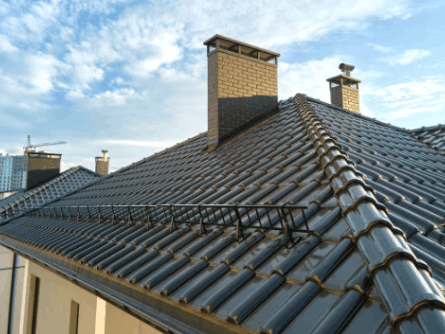
So, having reviewed the facts about roof tiles, what's the answer to our main question?
Do your tiles need to be sealed? Well, no - the choice is entirely yours, but the benefits are obvious!
The key is to hire experienced professionals, as this improves the sealant's ability to cope with the weather conditions for longer. The length of time your sealant lasts will vary depending on the type of paint/sealer used, the roofing material, and how well the surface was prepared. The sealant also needs time to cure properly if you want it to perform well.
When it comes to preparation, it's worth noting that a pressure washer isn't always a good idea as this can severely damage the roof tiles. Also, there's a fair chance of dislodging tiles or flooding your loft space! We strongly advise that you never attempt to pressure wash a roof yourself, due to the risks involved. Other, less aggressive methods are usually more effective and will not damage the tiles.
In the end, it's all about balance; sealing roof tiles can be an excellent idea, saving you money on repairs, improving your home's kerb appeal and extending its lifespan.
You might need to reapply sealant every few years to keep it performing at its best, particularly if you live in a coastal area or the weather is especially 'challenging', but an expert can help you decide if or when this is necessary.
So, it's all down to whether it's worth investing in a roof sealant or not. For most people, this move makes perfect sense. If your roof isn't very old and not heavily soiled, getting it professionally cleaned and sealed will ensure that it lasts a good long time. And if it's older and covered in moss, you could restore its appeal and lengthen its lifespan, avoiding the need for costly replacement.
Remember, though, it's not just about the practical side; a protective coating can also be coloured, providing a stunning new look for your property.
We hope this blog has been helpful and answered a few questions, but if you need any further information or advice, the Roof Clean Spray Team is happy to oblige!




